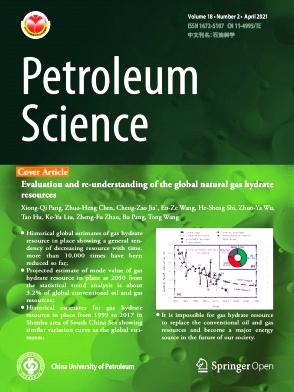Simultaneous seismic inversion of effective stress parameter, fluid bulk modulus, and fracture density in TTI media
IF 6.1
1区 工程技术
Q2 ENERGY & FUELS
引用次数: 0
Abstract
Predictions of fluid distribution, stress field, and natural fracture are essential for exploiting unconventional shale gas reservoirs. Given the high likelihood of tilted fractures in subsurface formations, this study focuses on simultaneous seismic inversion to estimate fluid bulk modulus, effective stress parameter, and fracture density in the tilted transversely isotropic (TTI) medium. In this article, a novel PP-wave reflection coefficient approximation equation is first derived based on the constructed TTI stiffness matrix incorporating fracture density, effective stress parameter, and fluid bulk modulus. The high accuracy of the proposed equation has been demonstrated using an anisotropic two-layer model. Furthermore, a stepwise seismic inversion strategy with the LP quasi-norm sparsity constraint is implemented to obtain the anisotropic and isotropic parameters. Three synthetic model tests with varying signal-to-noise ratios (SNRs) confirm the method's feasibility and noise robustness. Ultimately, the proposed method is applied to a 3D fractured shale gas reservoir in the Sichuan Basin, China. The results have effectively characterized shale gas distribution, stress fields, and tilted natural fractures, with validation from geological structures, well logs, and microseismic events. These findings can provide valuable guidance for hydraulic fracturing development, enabling more reliable predictions of reservoir heterogeneity and completion quality.
TTI介质中有效应力参数、流体体积模量和裂缝密度的同步地震反演
流体分布、应力场和天然裂缝的预测对非常规页岩气藏的开发至关重要。考虑到地下地层中很可能存在倾斜裂缝,本研究的重点是同时进行地震反演,以估计倾斜横向各向同性(TTI)介质中的流体体积模量、有效应力参数和裂缝密度。本文首先基于构造的TTI刚度矩阵,结合裂缝密度、有效应力参数和流体体积模量,推导出新的pp波反射系数近似方程。利用各向异性双层模型证明了所提方程的高精度。在此基础上,采用LP准范数稀疏性约束的逐级反演策略,获得各向异性和各向同性参数。三个不同信噪比的综合模型试验验证了该方法的可行性和噪声鲁棒性。最后,将该方法应用于四川盆地某三维裂缝性页岩气储层。结果有效地描述了页岩气分布、应力场和倾斜天然裂缝,并得到了地质构造、测井和微地震事件的验证。这些发现可以为水力压裂开发提供有价值的指导,可以更可靠地预测储层非均质性和完井质量。
本文章由计算机程序翻译,如有差异,请以英文原文为准。
求助全文
约1分钟内获得全文
求助全文
来源期刊

Petroleum Science
地学-地球化学与地球物理
CiteScore
7.70
自引率
16.10%
发文量
311
审稿时长
63 days
期刊介绍:
Petroleum Science is the only English journal in China on petroleum science and technology that is intended for professionals engaged in petroleum science research and technical applications all over the world, as well as the managerial personnel of oil companies. It covers petroleum geology, petroleum geophysics, petroleum engineering, petrochemistry & chemical engineering, petroleum mechanics, and economic management. It aims to introduce the latest results in oil industry research in China, promote cooperation in petroleum science research between China and the rest of the world, and build a bridge for scientific communication between China and the world.
 求助内容:
求助内容: 应助结果提醒方式:
应助结果提醒方式:


